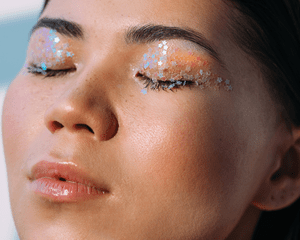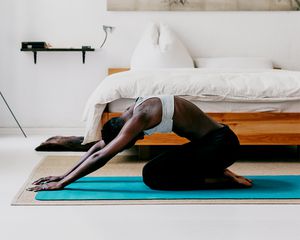:max_bytes(150000):strip_icc()/BYR_DI_CollageLead_Laughter_Recirc-abcdd3cd8dd045b996f582435a7b29c7-3f08feaa5ea44e1a990ec2a8d25521a0.jpg)
Stocksy
Laughter therapy—it's a real thing. And it's exactly what it sounds like: a therapeutic philosophy that relies on myriad techniques to make a person, well, laugh. "The body cannot tell the difference between simulated laughter and spontaneous laughter," explains Francine Shore, who founded the first "laughter yoga club" in New York City 13 years ago. "It's still going to release all the feel-good chemicals—dopamine, oxytocin, serotonin, and endorphins—and you get the same physiological and psychological health benefits."
Many adults have depressingly little laughter in their lives. "Children laugh about 150 times a day; adults laugh 12 times per day," Shore says. It's a shame, considering the dozens of mental health benefits a simple bout of laughter can have. "It decreases depression and anxiety, lowers blood pressure, is a natural pain analgesic [aka pain reliever], encourages positive thinking, boosts morale, enhances creativity and productivity, burns calories, and more," Shore says.
Shore has been both a teacher and practitioner of laughter therapy for years, and in the process, she has learned the (surprisingly simple) secret to lifelong happiness. Want in?
Start Your Morning With Gratitude
First thing every morning, before you even brush your teeth or hug your pet, write down three things you are grateful for. "Even if yesterday was the most challenging day or you're at a difficult juncture in your life, there are always three positive things to be grateful for," Shore says. The practice of physically writing down these positives and seeing them in front of you is "restorative," Shore says. It also guarantees that you approach your day from a place of contentment, not bitterness or wanting.
Smile
It sounds so basic, but Shore says that the mere act of smiling can trick your mind into feeling happier. "Your body releases endorphins simply by smiling," she says. To make sure you reach your daily smile quota, Shore recommends finding a laughter yoga club in your city or exploring online options. "They are usually free or just a few dollars; it's cheap therapy," she says. "In this political climate, the need to smile is more urgent than ever before."
Take a Deep Breath
Again, it's such a simple technique, but taking a few minutes to breathe deeply each day can have incredible mood-boosting effects. "Deep breathing and pranayama [techniques] expand your diaphragm, deliver oxygen to all the cells in your body, and get rid of the stale and toxic air that needs to leave your lungs," Shore says. "Both practices are centering [and] grounding and restore a sense of calm." Shore recommends taking a five- to 20-minute break whenever you can to close your eyes and focus on your breath. "Just don't meditate while driving!" she says.
Get Outside
Shore says the happiest people are those who "get out in sunshine and nature as often as possible. Nature has the ability to heal and awaken our senses; reduce stress, anxiety, and depression; and enhance creativity and productivity." The reason? According to Shore, nature reminds us that there is "something larger out there in the universe," which helps us reign in our egos. In addition, taking a moment to notice the beauty that surrounds us helps us remember that "there truly is good in the world," Shore says. You don't need to live next to the beach to experience the benefits of getting outside, either. Simply taking a walk in your neighborhood or spending an hour in the park can do the trick.
Bust a Move
Ever noticed that the giddiest people are always singing and dancing to themselves? Apparently, it's not just a symptom of happiness; music and dance actively make you happier. "All those years of singing in the shower have paid off for me," Shore says, who recommends belting it out in the car, in line at the grocery store, and walking down the street. The cardio exercise that comes with dance won't hurt either.
Wear Bright Colors
Whether they realize it or not, the world's happiest people practice "color therapy". "Always wear a pop of color, as it brightens your mood and has the ability to enhance somebody else's mood when they're with you," Shore says. Bringing color to your makeup, your home, or your desk can also "enhance creativity, productivity, and encourage positivity." If you're prone to feeling sad, try surrounding yourself with vibrant colors like bright yellow. If you tend to feel anxious, consider choosing something soothing like a muted green or lavender.
Volunteer
One of the keys to long-term, sustainable happiness is to step outside of the bubble of your life to do something selfless for other people. "Volunteering helps us develop a deeper sense of compassion and creates a sense of joy and community," Shore says. "It's a great way to get you out of your own head when you're feeling blue—to take the focus away from yourself and place it on someone else." Whether your activism is simple and local, like volunteering for an hour a week at an animal shelter, or is on a larger scale, it can bring you a strong sense of purpose.
Hug a Pet
"Pets provide a great source of entertainment and joy," Shore says. In fact, studies published in 2014 show that our blood pressure physically lowers when we pet and play with our animals. "They make us feel connected and have a very calming effect," Shore says. "They make us smile and laugh, plus your dog doesn't care what your hair looks like when you wake up in the morning or if you wear the same outfit two days in a row."
Watch Something Hilarious
"Did I mention Netflix?" Shore says. Becoming a happy person doesn't have to be a serious process. In fact, at the end of the day, Shore recommends doing whatever it takes to keep yourself laughing as much as possible. "Laugh often and laugh a lot," she says. While everyone else is going to see something sad, stay home and watch Bridesmaids. "Find the funny in the most ordinary of places," Shore says. "Choose levity in your life. It's a positive coping mechanism."
:max_bytes(150000):strip_icc()/BYR_2023Q1_Yara-LandingPage-RECIRC-c7463bd403da4c1c81089bf8503d2351.jpg)
:max_bytes(150000):strip_icc()/YaraShahidi_01_0149-16fb37d3e6594ed08e3b5abc561b2000.jpg)
:max_bytes(150000):strip_icc()/25173-2-0004_Recirc-3a2851884b664fdca69771158213e7c6.jpg)
:max_bytes(150000):strip_icc()/BYR_DI_CollageLead_EditorsPicks_Recirc-a172b17cfafb4c0fb5eaffeb526f4729.jpg)
:max_bytes(150000):strip_icc()/BYR_DI_CollageLead_Drinking_Recirc-780b34ffb33741ec9301f794ac3bdc1e.jpg)
:max_bytes(150000):strip_icc()/BYR_DI_CollageLead_Thrifting_Recirc-3fc827b14b614298b7e4cfd4c08b1401.jpg)
:max_bytes(150000):strip_icc()/BYR_DI_CollageLead_Laughter_Recirc-abcdd3cd8dd045b996f582435a7b29c7.jpg)



